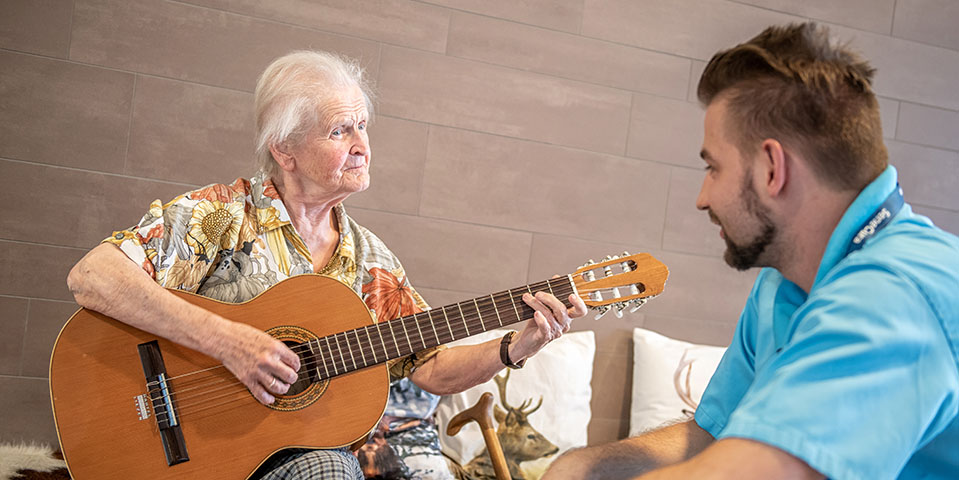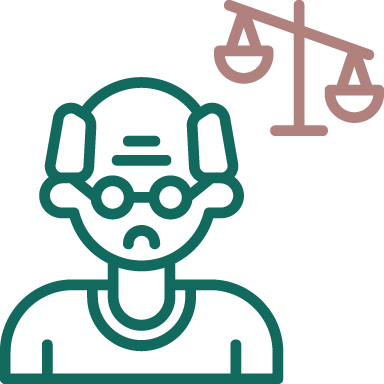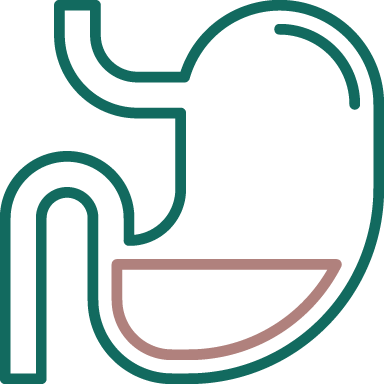Alzheimer's Disease
Providing care in difficult cases
When you think of Alzheimer’s disease, the first image which often comes to mind is that of memory loss and confusion. Unfortunately, the symptoms of Alzheimer’s disease are not limited to these cognitive difficulties which are already highly disabling. There are also various neurobehavioural symptoms such as aphasia, apraxia and mood or behavioural disorders.
At each stage of disease progression, and with each disorder, it’s necessary to adapt your behaviour. But how?
What’s important to remember is that there is not one Alzheimer’s disease, but a multitude of Alzheimer’s diseases, as so many disorders are involved. Here are some of them: Here are some of them:
Aggression
Perhaps one of the most difficult and painful behaviours to deal with is aggression.
Aggression is a neurobehavioural symptom and a common disorder in people with dementia. The first thing to do to overcome these attacks is to try to determine their origin and what is behind them. Uncertainties and dissatisfactions, feelings of isolation, misunderstanding, fear, revolt and anxiety, the causes of physical or verbal aggression are as diverse as they are numerous.
First and foremost, ask yourself if there is an unmet need: hunger, thirst, sleep etc. and/or underlying symptoms: pain, fever etc.
You should never feel personally attacked and never respond to aggression with aggression. It is therefore advisable to remain calm and smiling, and to find the most appropriate way of letting the patient know that their reaction has been perceived and understood. As a general rule, there is no point trying to show patients that they are wrong. Instead, other attitudes can be adopted:
- Divert patients by changing the subject;
- Take the person to a more isolated place;
- Or on the contrary, leave them alone for a while;
- Or offer an occupational activity.
The caregiver must know their tolerance threshold. Once this threshold has been exceeded, caregivers should not hesitate to ask for help and, if possible, to hand the patient’s care over to someone else.
Disorientation
Another classic disorder in Alzheimer’s patients is disorientation
Temporal and spatial disorientation, i.e. difficulty in finding your bearings in time and space, is directly induced by the loss of memory. Patients go back and forth and live between the present and the past. They thus place people and events from the past in the present. This can lead, for example, to them calling for their father or mother or asking if they can pick their children up from school. As the disease progresses, there is a mash-up of old memories with recent events.
When confronted with this, you should not, under any circumstances, try to reorient people to the present by reminding them, for example, of the age of their children or the death of their parents, nor should you try to maintain a lie to mask reality. The right attitude to adopt is to compromise by trying to find a bridge between the patient’s reality and yours in the form of a diversion. Talk about their children’s education or a memory of their parents. It will then become possible to validate the emotions the patient is trying to express.
Wandering
Another common behavioural disorder is wandering
Wandering is defined as a prolonged and repeated need to walk, sometimes aimlessly. Walking is a means of calming high anxiety that cannot be expressed through words.
The thing to do is make the space where the patient is going to move around as safe as possible. Remove anything that could be an obstacle and cause a fall (carpets, small items of furniture, decorative objects on the floor etc.). It is also important to ensure that patients are wearing proper shoes and, perhaps surprisingly, that they are eating enough. Their daily efforts require a sufficient nutritional intake.
Care must also be taken to anticipate wandering, as patients who wander can put themselves in danger. When outside, they are unable to find their way and reorient themselves in space, to recognise their street, their house or to react appropriately to get their bearings. They often go in search of a familiar place; their childhood home, for example.
In order to cope as best as possible with their compelling need to wander, you can offer to accompany them on regular walks. You should also make sure that the neighbourhood and local shopkeepers are aware of the problems your loved one is suffering from and the risk of their getting lost. You should also remember to mark their clothes and put copies of their identity papers in their clothes.
Testimonial : Yesterday's job, today's therapy

The patient is an 89-year-old retired woman who worked as a head midwife. She is a widow with four children.
She was 78 years old when she developed mixed neurological disorders (vascular and cognitive) with affective lability (the slightest emotion generates a reaction which is difficult to control) and severe irritability.
At the time of her admission, she has significant behavioural problems with aggression towards others. The intention is to admit her to the adapted care unit (ACU) for a better approach. Her family is opposed to this, and the resident herself does not understand what she is doing in this unit and thus refuses to stay there. The patient continues to wander erratically and falls several times.
Given her former profession in healthcare, the medical team gives her an activity related to the tasks she performed in her job in the hospital and observes her reaction. She is first given some bandages to prepare (like those for the neonate’s navel), which makes her concentrate on the task and reduces the wandering and irritability she showed.
Then she is told that the team relies on her to supervise the staff working in the ACU to which she has access. To do this, she is asked to keep a notebook in which she takes notes on the team. She performs her role perfectly and is soothed for long periods.
The family is invited to visit her in the ACU for a pre-arranged therapeutic purpose. Observing their mother’s good response, they agree to her admission on an ongoing basis, noting that she is receiving comprehensive supervision which takes into account her needs and situation. Today, she continues to live in the centre she joined in 2011.















